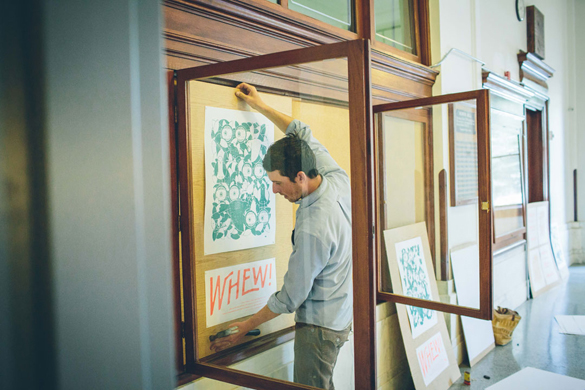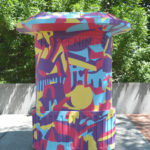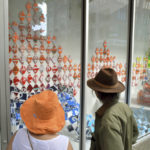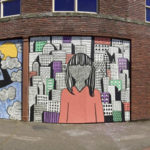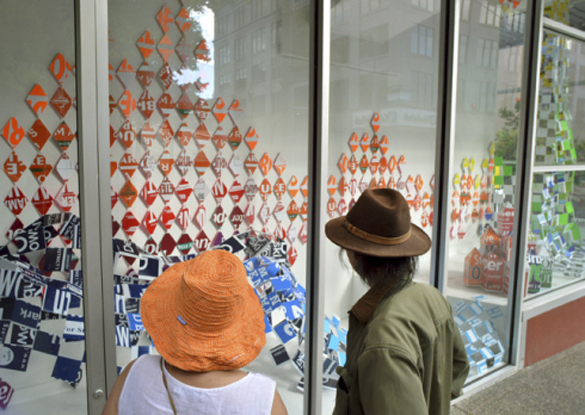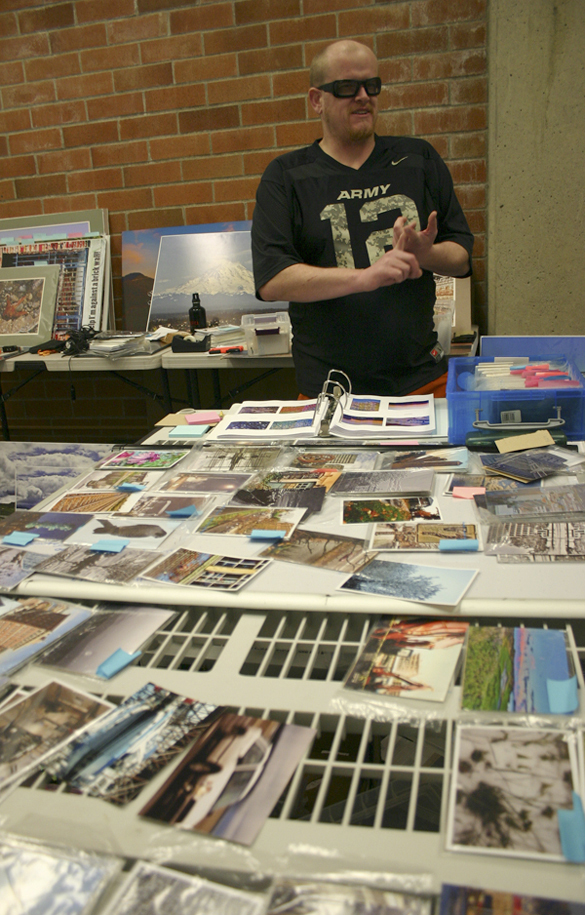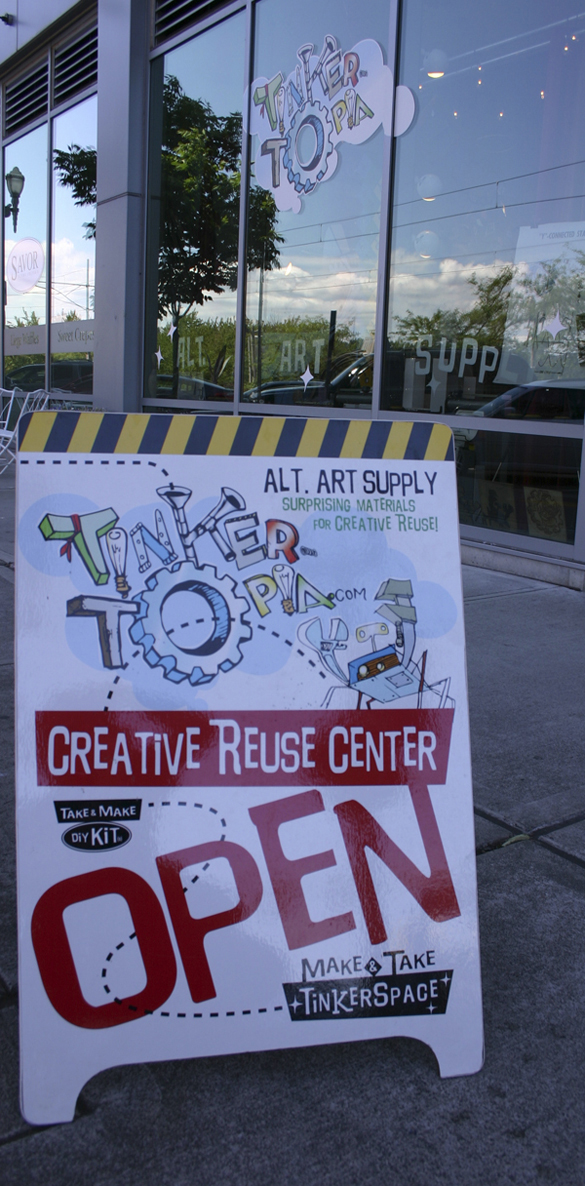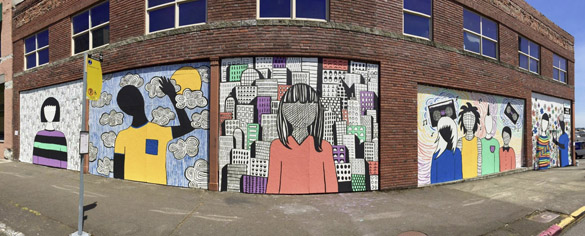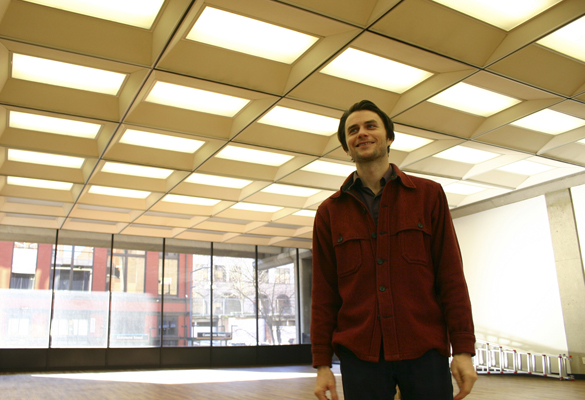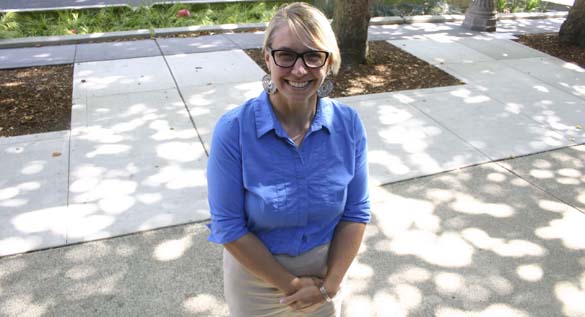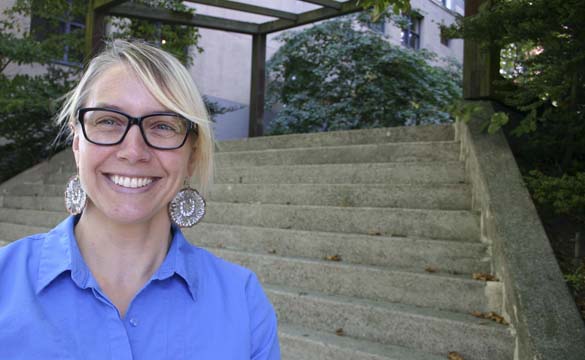Few things rankle downtown boosters more than empty storefronts. In Tacoma, one program has made serious headway in turning these “dead zones” into potential sites for aspiring small-business owners. Founded in 2010, Spaceworks Tacoma—a joint initiative of the City of Tacoma and the Tacoma-Pierce County Chamber—helps artists and creative entrepreneurs activate the city’s vacant spaces.
The program accomplishes this goal in three different ways.
Artscapes turns storefront windows and outdoor wall spaces into canvases for local artists—the Woolworth Windows near Broadway and South 11th Street; the Tacoma Post Office Lobby at 1102 A St.; a concrete kiosk near Market Street and South 13th Street; a building facade near Market Street and South 11th Street; and the Tollbooth Gallery near Broadway and South 11th Street.
Another approach uses empty spaces for special projects and pop-up events for very short-term periods.
But Spaceworks Tacoma’s Creative Enterprise program arguably does most of the heavy lifting when it comes to filling vacant storefronts in ways that are both very visible and drivers of the local economy. Creative entrepreneurs accepted into the 16-week program receive business training and peer support, as well as Spaceworks Tacoma’s expertise in finding a suitable storefront at very reasonable lease rates (typically a dollar a month, plus utilities) for what is usually the first six months of business. After that initial start-up period, the tenant and the property owner typically decide whether to enter into a lease agreement of their own.
According to Spaceworks Tacoma officials, 75 per cent of businesses that participate in the Creative Enterprise program and find retail spaces go on to become lease-paying tenants.
“That’s one of the things that the property owners are most excited about,” said Spaceworks Tacoma Program Manager Heather Joy during an interview last week at the Tacoma-Pierce County Chamber’s headquarters in downtown Tacoma. Joy—a photographer and small-business owner who managed the EDGE Professional Development Program at Artist Trust—was hired in March of 2013 to lead Spaceworks Tacoma. “We are basically handing them smart and exciting businesses that are going to turn into lease-paying tenants. Over the course of the last year, we’ve had a handful of property owners seek us out and want to work with us. That’s really exciting and that’s a big shift.”
Equally as interesting as activating storefronts is the kind of business that often moves into one of these empty spaces—graphic designers, theater producers, photographers, clothing retailers, and other artisans.
One success story is Tinkertopia, the DIY art supply store in downtown Tacoma. Husband-and-wife co-owners (and artists) Darcy Anderson and Richard Ryan “R.R.” Anderson submitted an application to Spaceworks Tacoma in August of 2012 and spent most of one year working with Spaceworks Tacoma staff to create a business plan and scout locations before they settled on a storefront located at 1914 Pacific Ave., in a building owned by the University of Washington Tacoma. The Andersons eventually signed their own lease with UW Tacoma.
“We’re two artists who didn’t have any business savvy,” R. R. Anderson told the Tacoma Daily Index in July. “Spaceworks gave us all these tools and a flow chart of things we needed to do. Things you don’t think about as just the hippy-dippy artist.”
“I am very proud of how it has evolved into something more wonderful than I could have imagined,” said City of Tacoma Arts Administrator Amy McBride, who envisioned and championed the idea five years ago. “It’s one thing to have an idea and even work to develop it with a solid concept and goal for success and sustainability. It’s a totally other thing to see it evolve and actually work.”
Earlier this year, Spaceworks Tacoma embarked on its most ambitious project so far—1120 Creative House, a co-working space located in a downtown Tacoma high-rise that offers studios for artists and designers.
Spaceworks Tacoma is funded by the City of Tacoma and grants from the federal Community Development Block Grant (CDBG) program, the National Endowment for the Arts, the Greater Tacoma Community Foundation, and Ovation. Similarly, the City and the Chamber provide in-kind donations such as staff resources and office space. Joy works full-time alongside part-time Artscapes and marketing coordinator Gabriel Brown and part-time summer intern Andrea Michelbach.
“Heather Joy is phenomenal,” said McBride. “She puts her heart, soul, and joy into the program. She is committed to what’s best for artists and creatives, she cares deeply about our clients and about Tacoma, and her passion is palpable. She’s creative, hard working, committed, and believes whole heartedly in our clients and what Spaceworks can do to make Tacoma awesome.”
According to Joy, the program has activated 43 underused properties, assisted 73 creative businesses, and exhibited 106 large-scale art installations around Tacoma over the past five years.
Spaceworks Tacoma will mark its fifth anniversary during a community celebration in the Hilltop neighborhood on Sat., Sept. 12. I recently met Joy to discuss the program’s past, present, and future. Excerpts of our conversation are included in today’s edition of the Tacoma Daily Index. Our interview has been edited for clarity and abridged for publication.


TACOMA DAILY INDEX: Were you aware of Spaceworks Tacoma before you were hired [as the program manager]?
HEATHER JOY: I was. I used to live in Seattle, so I was more familiar with Storefronts [Seattle] and had actually applied to Storefronts as a small-business [owner] and artist. I’ve also known about Tacoma’s art community since the early 2000s. I just remember Tacoma being a great destination for artists. As an artist, I did a Woolworth Window in Tacoma in 2007. I was always looking at Tacoma as a great spot for artists.
INDEX: Are there other Spaceworks programs in other cities?
JOY: There are other programs similar to Spaceworks, but Spaceworks is its own unique program that was created in Tacoma. It was created with the Chamber, the City, and Shunpike in the early years. They took the model and did it in Seattle with [the] Storefronts [program].
Other cities across the country have identified the fact that artists are a great way to activate vacant storefronts, and that arts and culture are things that revitalize communities. Other communities have done those sorts of things, and we’re often looking at other communities and how they are doing it. There are other really awesome grants out there for projects like that, too, so looking at those and seeing who [has been] funded has been helpful for us because the other thing is: Why recreate the wheel? That’s one of my biggest beliefs—figuring out how we can learn from other organizations.
We are also helping to inform other communities that want to start things like Spaceworks. We recently worked with Spokane. They had been doing [the] Window Dressing [program] for several years. That would be similar to our Artscapes program. They see what we’ve done and what some other communities have done, and now they are launching something similar to our Creative Enterprise program and working with small businesses. But it’s a huge undertaking. Identifying the challenges, what works, what doesn’t work—we were trying to help inform them and give them insight into what we’ve learned, because there has been a lot.
INDEX: I’m guessing the economy was a lot different in 2010 than it is today. How much does the economy play a role in whether you can get empty storefronts? Do you think there will be a point where there won’t be any empty storefronts to activate?
JOY: It’s great to see more storefronts filled and to think that Spaceworks wouldn’t be needed in terms of filling those vacant spaces. On the other hand, what I have learned—and this is what I’m excited about for the future of Spaceworks—is that we are helping to train exciting and innovative businesses that wouldn’t potentially be able to hit the street without our support. As a service provider, we should exist. That’s exciting to think about for the future in terms of what we can offer.
I remember [Storefronts Seattle Program Manager] Matthew Richter saying years ago, “If I do my job right, I’ll be out of a job because we will have filled all of the vacant storefronts.”
I don’t think that’s how Spaceworks looks at it anymore—if we ever did. What we are offering is unique and important for the small, creative businesses we’re working with.
Also, to maintain the arts and culture that every city needs. Plenty of cities have seen the economy turn around and those entities get pushed out because they can’t afford it anymore. That’s one of the other future plans for Spaceworks—to hopefully help secure affordable space for arts and cultural activities. I’m excited about that.
INDEX: Can you explain the lease process [for Creative Enterprise program participants]?
JOY: We sign a lease with the property owner. It’s usually month-to-month with the understanding that the goal is to have it for six months. After six months, that tenant will start leasing directly from the property owner. We do month-to-month to let [the property owner] know they have an out. If someone comes along and says they will pay full rent, we will leave in 30 days. That seems to be more appealing to the property owners—or at least it was historically. However, it’s shifting for some of the property owners because they are willing to commit for six months knowing that business feels secure and is working toward paying rent on day one of month seven.
INDEX: During that time, does the business owner pay anything?
JOY: They pay a dollar a month for rent. So Spaceworks has the lease, we take on all the utilities, we take on everything under Spaceworks’ name—under the Chamber’s name—and then we put a small business in there who then pays Spaceworks a dollar per month for rent. They are basically reimbursing us for what we are paying the property owner, and we are paying the property owner a dollar a month for rent—plus utilities.
INDEX: Spaceworks Tacoma is a program of the City and the Chamber. What is the annual budget for Spaceworks and who pays for what?
JOY: The cash budget is currently around $150,000 to $180,000. But the overall budget is closer to $400,000 because of all the in-kind donations from property owners, the Chamber, and the City. The Chamber doesn’t give any cash money to the program, but they provide us with space, our computers, IT, HR, bookkeeping—all of those things are given to the program and don’t come out of our cash budget, which is huge. It’s like $30,000 or $40,000. And then [City of Tacoma Arts Administrator] Amy [McBride] puts in a lot of time on fundraising and programming.
Several months before I started, they weren’t even sure if Spaceworks was going to continue because of funding. The City was the primary funder for Spaceworks from its arts program. Then it became a possibility that Spaceworks could apply for CDBG funding because we are an economic development driver. We submitted an application for [CDBG] funding and we were awarded [funds] starting in June of 2013. That was kind of the real turning point for Spaceworks to be more stable. We have to apply every year for that, but we are meeting the goals that are put forward in the grant. It’s federal money that is distributed by the City.
It’s always interesting to me in terms of where the money comes from. It’s my impression the public may see Spaceworks as being funded by the City and the Chamber: What a great service and resource for the community, and they are taken care of. This year there has been a real push to shift that mind-set so the community understands that we actually are seeking grants from foundations, donations from individuals, and we are seeking corporate sponsorship from local businesses. We are doing all the things that any other non-profit out there is doing to help fund itself. The money from the City in terms of general fund dollars out of the arts program is about an average of $18,000 per year. The CDBG grant is around $70,000. So we have to find the rest of the money from other sources.
Recently we got a $5,000 grant from the [Greater Tacoma Community Foundation] to help with our capacity building. Our project is to have a database and do what all other non-profits do, which is to track everything better than we have been doing. I’m actually very excited about that grant because that is really going to help with our capacity and our internal knowledge base.
INDEX: Do you think Spaceworks Tacoma could be its own non-profit organization separate from the City and the Chamber at some point?
JOY: I do, personally. I know that our steering committee has talked about it. But we also understand the complexity of that and that it will be a lot of work. One of the big things we are working on in the next year is doing a strategic plan to figure out the future and what that would take if we chose to do that. Right now, it is a great fit with the Chamber because we are working with small businesses. All of the support that they provide is huge. What’s best for the program is what needs to be decided.
INDEX: When I think of Spaceworks, I think of it being in downtown Tacoma and the Hilltop neighborhood. Is it in other areas of the city?
JOY: We’ve had a couple of businesses who have identified areas in the city that would work best for them. They have either gone on and leased their own space, or we have facilitated a space match for them. For example, in Ruston, which isn’t actually part of the City of Tacoma, Kerry Cole opened Blue Octopus and that was a Spaceworks site. The Nearsighted Narwhal was looking all over the city. They identified Sixth Avenue as the right space for them and ended up leasing that space on their own. They had gone through our training program and we continue to provide them with marketing support and that sort of thing.
The City really wants us to move into new neighborhoods. We’re trying to build capacity to do that. I’ve met with the folks down in South Tacoma and a couple people in [the] Lincoln [District]. [The] McKinley [neighborhood] would love to see us out there. Finding property owners that are willing to work with us is always the biggest hurdle. We’re constantly working on developing those relationships. Also, it’s hard for me to put one Spaceworks site out there by itself. It’s better to cluster, which is what we have done on Martin Luther King Jr. Way. So trying to find more than one property owner is also part of the goal.
INDEX: I have this idea in my mind that Spaceworks is almost like a matchmaking organization between property owners and artists.
JOY: It is.
INDEX: So how much time do you spend scouting a location, you almost have a deal, but then one person doesn’t like that location, or the property owner doesn’t like the business?
JOY: I go to my roster and I say, “How about this space?” They say, “No. my clients don’t frequent that neighborhood.” Or they say, “There’s too much tenant improvement work.” We were looking at the [old] Buzzard’s space [near UW Tacoma] and it needs a bathroom and plumbing and it’s going to be probably $5,000 to $10,000. To ask my businesses, who aren’t even ready to start paying rent, to come up with an improvement like that is impossible.
So either figuring out if the property owner is happy with who I’m bringing them, and whether the clients are happy with the property, it takes a lot of time and work and energy.
INDEX: What does the future look like for Spaceworks Tacoma? Are you still going to be here?
JOY: I love my job. I am a very lucky person. I get to work with amazing artists and people who are trying to make Tacoma better. It’s very diverse every single day. I’m working with property owners and artists and it’s like I’m doing program management and fundraising and marketing and all of these prongs that make it exciting every day. We’re working on some new funding sources that we’re really excited about and hopefully will take us to the next level. There are potential properties out there that we will be very excited to announce when they come on.
Also, I’m invested in Tacoma. I live here now. I’m an artist. My husband is an artist. We have a small business. I think that the future is bright for Tacoma but it’s going to take all of us working together to get there. I’m excited about my job.
More information about Spaceworks Tacoma is available online at spaceworkstacoma.com.
Todd Matthews is editor of the Tacoma Daily Index, an award-winning journalist, and the author of several books. His journalism is collected online at wahmee.com.
To read the Tacoma Daily Index‘s complete and comprehensive coverage of Spaceworks Tacoma, click on the following links:
- Spaceworks Tacoma celebrates 5th Anniversary (Tacoma Daily Index, Aug. 13, 2015)
- Tinkertopia: Tacoma’s DIY art supply store turns 2 (Tacoma Daily Index, July 16, 2015)
- Donations accepted May 17 for Tacoma Tool Library (Tacoma Daily Index, May 14, 2015)
- Spaceworks Tacoma: 1120 Creative House grand opening March 19 (Tacoma Daily Index, March 11, 2015)
- Tacoma Daily Index Top Stories — February 2015 (Tacoma Daily Index, March 2, 2015)
- 1120 Spaceworks: Creativity abounds in a downtown Tacoma office building (Tacoma Daily Index, Feb. 20, 2015)
- Spaceworks Tacoma opens downtown co-working space (Tacoma Daily Index, Feb. 9, 2015)
- Spaceworks Tacoma opens downtown co-working space (Tacoma Daily Index, Feb. 9, 2015)
- 5 artisan Tacoma furniture makers to open Dome District showroom (Tacoma Daily Index, December 10, 2014)
- Apply today for 2015 Spaceworks Tacoma program (Tacoma Daily Index, October 20, 2014)
- Winters, Spaceworks Tacoma earn historic preservation awards (Tacoma Daily Index, May 6, 2014)
- New clothing retailer to open on UW Tacoma campus (Tacoma Daily Index, April 29, 2014)
- 2 new Spaceworks Tacoma murals brighten 11th & Market (Tacoma Daily Index, March 25, 2014)
- 3 Spaceworks Tacoma art installations debut New Year’s Eve (Tacoma Daily Index, December 20, 2013)
- Murray Morgan Bridge, Dorky’s Arcade earn New Tacoma Awards (Tacoma Daily Index, July 12, 2013)
- Dorky’s Arcade, Spaceworks among New Tacoma Award nominees (Tacoma Daily Index, July 2, 2013)
- Deadline Friday for New Tacoma Award nominations (Tacoma Daily Index, June 18, 2013)
- Spaceworks Tacoma seeks artists for storefront installations (Tacoma Daily Index, May 24, 2013)
- Walk Tacoma series continues April 17 with downtown art tour (Tacoma Daily Index, April 10, 2013)
- Tacoma artists encouraged to apply for TAIP grant (Tacoma Daily Index, December 27, 2012)
- Volunteer today for Tacoma Arts Commission (Tacoma Daily Index, September 6, 2012)
- DIY Downtown: Spaceworks Tacoma, indie retailers fill vacant storefront (Tacoma Daily Index, August 15, 2012)
- Former Sauro’s Cleanerama site subject of downtown art exhibit (Tacoma Daily Index, April 10, 2012)
- Spaceworks Tacoma settles into Hilltop neighborhood (Tacoma Daily Index, February 22, 2012)
- Spaceworks Tacoma seeks energetic projects (Tacoma Daily Index, December 13, 2011)
- Spaceworks installations light up downtown this winter (Tacoma Daily Index, November 29, 2011)
- 9 artists selected for upcoming Spaceworks Tacoma installation (Tacoma Daily Index, October 20, 2011)
- Milk. Eggs. Bread. Art? New downtown Tacoma supermarket will showcase local artists (Tacoma Daily Index, September 1, 2011)
- Celebrate Spaceworks Tacoma’s first anniversary (Tacoma Daily Index, August 10, 2011)
- ‘Words’ tells story of fun, creativity in downtown Tacoma’s Tollefson Plaza (Tacoma Daily Index, August 8, 2011)
- “Words” drop in Tollefson Plaza Aug. 6 (Tacoma Daily Index, August 2, 2011)
- Spaceworks Tacoma launches new online map (Tacoma Daily Index, July 20, 2011)
- Spaceworks Tacoma seeks artists for downtown installations (Tacoma Daily Index, May 13, 2011)
- Spaceworks Tacoma receives New Tacoma Award (Tacoma Daily Index, April 1, 2011)
- Frost Park chalk artists among New Tacoma award nominees (Tacoma Daily Index, March 23, 2011)
- Apply today for Spaceworks Tacoma residency, creative enterprise programs (Tacoma Daily Index, March 7, 2011)
- New Spaceworks installations hit downtown Tacoma storefronts in March (Tacoma Daily Index, February 22, 2011)
- Enjoy Spaceworks’ Trick-Art-Treat downtown Oct. 28 (Tacoma Daily Index, October 21, 2010)
- Art spelled out in Tollefson Plaza (Tacoma Daily Index, August 4, 2010)
- Spaceworks Tacoma block party July 29 (Tacoma Daily Index, July 6, 2010)
- Artists invited to Spaceworks Tacoma meeting April 28 (Tacoma Daily Index, April 20, 2010)
- Tacoma artists needed for downtown storefront installations, performance art (Tacoma Daily Index, April 2, 2010)
- (Creative) Space Available: Pilot project pairs artists, vacant storefronts (Tacoma Daily Index, March 12, 2010)
